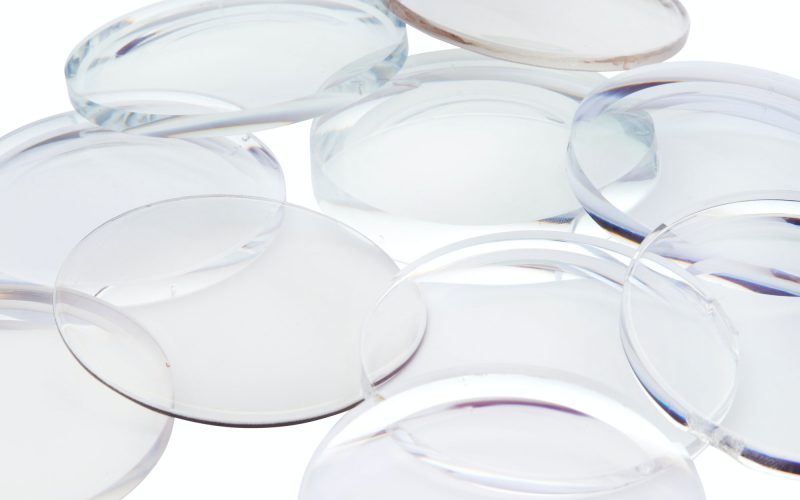If you find yourself in the position to purchase a new pair of glasses, you may stumble across the phrase “lens index.”
Lens index is a measurement on the lens thickness chart that dictates the thickness of your lenses. Made from higher-quality material, a high index lens will be able to deliver more powerful correction without the need for thicker lenses.
What is a Lens Index?
The lens index is a numerical representation of the refractive capabilities of a lens’s material. Certain materials, especially those in high index lenses, are able to bend light more efficiently.

What is a High Index Lens?
A lens that is rated at a higher index can slow and bend light rays more effectively than standard index lenses. Because the quality of the material uses light more efficiently, the need for additional material to alter the path of light rays is unnecessary.
Simply put, if you have high index lenses, they will be thinner. Conversely, if your prescription glasses are fitted with lower lens index material, they will be thicker.
The lens index chart ranges between 1.5 standard index to 1.74 high index.
Lens Materials
The quality of a lens is measured on the lens index chart. A difference in the lens index of your glasses can have a dramatic effect on your lifestyle. Low lens index glasses will be thicker but more affordable and only offer a low vision correction level. High index lenses have less material, making them thinner, lighter, and customized to address a wide range of vision correction.
1.5 Standard Index
A 1.5 standard index lens is suitable for people with a weak prescription looking for an affordable option.
1.5 standard index lens are suitable for prescriptions with an:
- SPH correction of +/- 2.25 and less, or;
- CYL correction of +/- 1.50 and less
1.56 Mid-Index
The core difference between a 1.56 mid-index lens and 1.5 standard lenses is the lens’s thickness. A 1.56 mid-index lens will still require full-rim glasses but can be useful for athletes during physical activity.
1.57 Thin & Light Index
People who require a moderately strong prescription can choose 1.57 thin & light index lenses as they are thinner and lighter than standard lenses.
1.57 thin & light index lenses are suitable for prescriptions with an:
- SPH correction of +/- 5.00 and +/- 4.00, and;
- CYL correction of +/- 3.00 and less
1.59 Polycarbonate
1.59 index lenses are incredibly resilient, offer UV protection, and are impact resistant. These lenses are made from a unique polycarbonate material and can be tailored to the individual. Coatings such as scratch-resistant or anti-reflective can be applied to 1.59 index lenses for additional security.
1.61 High Index
1.61 high-index lenses offer an ultra-thin option for those looking for a modern, stylish look. Able to be fitted into thin frames, 1.61 high-index lenses are perfect for everyday wear.
1.61 high-index lenses are suitable for prescriptions with an:
- SPH correction of +/- 4.25 and +/- 6.75, and;
- CYL correction of +/- 2.25 and +/- 3.00
1.67 High Index
1.67 high index lenses are incredibly thin and light, even surpassing 1.61 high-index lenses. This lens index is an excellent option for those with an extra-strong prescription.
1.67 high index lenses are suitable for prescriptions with an:
- SPH correction of +/- 7.00 and +/- 9.00, and;
- CYL correction of +/- 3.25 and +/- 4.00
1.74 High Index
The thinnest option available and designed for those with the highest prescriptions, 1.74 high index lenses are the optimal choice if you have a high prescription.
1.74 high index lenses are suitable for prescriptions with an:
- SPH correction of +/- 9.25 and more, and;
- CYL correction of +/- 4.25 and +/- 6.00
Do You Need High Index Lenses?

If you’re looking for a pair of glasses that are light, can be set in semi-rimless or rimless frames, and have a sleek modern look, high index lenses may be the best choice for you. However, if you’re physically active throughout the day or frequently engage in sports, a pair on the lower end of the lens index may be more suitable.
Keep in mind, you should speak with an optician before deciding on the lens material.
Lens Index FAQs
What are the materials used in high index lenses?
High index lenses are constructed from a specific polymer that can bend and refract light more efficiently, requiring less physical material than standard index lenses.
Why do high index lenses cost more than standard index lenses?
The material used in the manufacturing of high index lenses inherently costs more to produce. While the lenses may be more expensive than standard index lenses, the benefits far outweigh the extra cost.
Do I need high index lenses?
If you’ve been given a strong prescription to correct your vision, high index lenses are an optimal choice. These lenses are extremely lightweight, making them comfortable to wear all day. They can be fitted to a variety of frames, allowing you to pick a pair that matches your personality.
Shop at Felix Gray
To find the best frames, Felix Gray offers the variety you want regardless of your lens index. Combined with our innovative lens technology, such as Blue Light filter glasses and sleep glasses, you’ll fall in love with your new pair of glasses. Contact Felix Gray today, and shop with peace of mind thanks to our free shipping and free returns policy.
